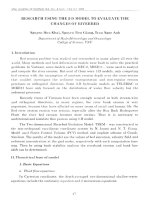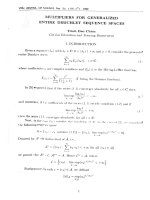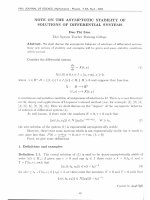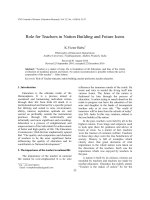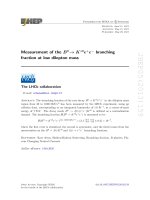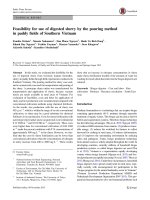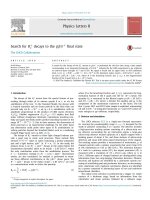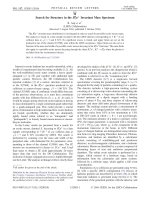DSpace at VNU: Method for the partial wave scattering problem for the quantum field theory
Bạn đang xem bản rút gọn của tài liệu. Xem và tải ngay bản đầy đủ của tài liệu tại đây (224.31 KB, 9 trang )
Method for the
partial wave scattering problem for the
quantum field theory
Nguyen Dinh Thinh
Hanoi University of Science, VNU; Faculty of Physics
Major: Theoretical Physics - Mathematical Physics
Code: 60 44 01
Supervisors: Prof.PhD. Nguyen Xuan Han
Date of Presenting Thesis: 2011
Abstract. Nghiên cứu các phương pháp giải phương trình Schrodinger trong
cơ ho ̣c lươ ̣ng tử: phương pháp khai triể n theo sóng riêng phầ n ; phương pháp
hàm Green; phương pháp chuẩ n cổ điể n ; mối liên hệ giữa biên độ tán xạ theo
sóng riêng phần và biên độ tán xạ eikonal. Trình bày sơ đồ mối liên hệ giữa các
phương pháp của bài toán tán xạ. Phân tích các hiê ̣u ứng hấ p dẫn và điê ̣n từ
trong bài toán tán xa ̣ ở năng lươ ̣ng Plangck như tán xa ̣ toàn phầ n toàn phầ n hấ p
dẫn; cực điể m của tán xạ; tán xạ hấp dẫn có kể thêm tương tác điện từ.
Keywords. Sóng; Vật lý lý thuyết; Tán xạ; Trường lượng tử; Vật lý toán
Content.
In recent years there have been important advances in our understanding of
scattering at the Planck scale energy in quantum field theory / 1-10 /. To study
this process in the theory of quantum gravity will provide a scientific basis to be
aware of physical phenomena such as the birth of the singularity and the
formation of black holes, the loss of information as well as the improvement
variable's string theory of gravity. The results obtained are confirmed Planck
scattering amplitude of high-energy particles in the size (where s is the energy of
the hat, is the Planck mass, - is the gravitational constant) and t-squared pulse of
transmission is small, within the limits of the form eikonal representation representation Glauber (leading term) phase depends on energy. Additional
terms of (non-leading terms) in the scattering problem has been many domestic
and foreign scientific research interest over 20 years, including the Department
of Theoretical Physics National University of Hanoi. Initial results of the
-1-
Department of Physics theory is to find the first-order terms added to the terms
of the amplitude eikonal scattering amplitude in the theory of quantum gravity,
using both methods are different methods of analysis distributed gossip content
and the standard equation. / 8-9 /. Finding other methods for this problem is still
topical issues.
- It offers three methods of solving the Schrodinger equation to find the
scattering amplitude in which the partial wave method. A comparison of three
methods to help us have different directions for the scattering problem in
quantum mechanics.
- Method of partial waves used in quantum mechanics is generalized, then it
is used to study the scattering problem in the Planck energy theory of quantum
gravity
I. The Schrodinger equation method
1.Phuong method developed by the
partial wave
Schrodinger equation:
.
Total wave function describing the motion of the
r ự r
r
ộ h2 2
ờỳy (r ) = E y (r )
ẹ
+
U
(
r
)
ờ 2m
ỳ
ở
ỷ
particle toparticle scattering and at large distances (r> a) for interest equal to the
sum of scattering and wave to the scattered wave:
r
e ikr
ikz
Y(r ) = e + f ( q, j )
r
Return to R equations obtained radial equation of the form:
ử m
1 d ổ
ỗỗr 2 dR ữ
ữữ 2R+ lR = 0
r 2 dr ỗố dr ữ
ứ r
scattering amplitude in partial waves
Ơ
f ( q) =
ồ
gl Pl (cos q) =
l= 0
-2-
1
2ik
Ơ
ồ
l= 0
(2l + 1)(e
2i dl
- 1)Pl (cos q)
2. Green function method
Schrodinger equation:
r
r ur
éÑ 2 + k 2 ùy (r ) = U (r )y (r )
ú
ëê
û
,
Equation can be rewritten as integral equation:
r
r
y (r ) = f (r ) +
r ur
r
r
3
d
r
'
G
(
r
,
r
')
U
(
r
')
y
(
r
')
ò
0
,
Under the boundary conditions, the wave function must includetwo components:
component waves to the plane wave traveling inthe
positive z axis and the rest is scattered spherical wave. Sorewritten as:
ur
r r
1
i k .r
y (r ) = A0e 4p
r r
ik r - r '
r r
e
ò d r ' r r U (r )y (r ')
r- r'
3
Scattering amplitude in partial waves
f (0) ( q) =
k
i
ò
¥
0
b ' db ' J 0(kb ' q) éêe i c (b ') - 1ù
ú
ë
û
3. The standard method of classical
Also derived from the Schrodinger equation (and test of the equation of the
form:
y = e iS(x)/ h
So the Schrodinger equation we obtain:
é h2 ¶ 2
ù iS/ h
êúe
+
U
(
x
)
= Ee iS/ h
ê 2m ¶ x 2
ú
ë
û
-3-
1 h
1
S ''+
S '2 = E - U
2m i
2m
In the classical limit, and instead we have:
S '(x )2
h 2k 2
=
- U (x )
2m
2m
Integral expression
S
=
h
z
òU
2m
U ( b2 + z '2 )dz '+ const
2
h
k2 -
- L
Derived from the wave function of the form:
1
y =
e ikze
3/ 2
(2p )
-
z
im
òU(
h k
2
b2 + z '2 )dz '
- L
(
The scattering amplitude is written:
f (k ', k ) = é im
´ exp êê- 2
êë h k
1 2m
4p h 2
r r
rr
3
- ik ' x '
2
2 ikx '
ò d x ' e v( b + z )e
ù
ò U ( b + z ' )dz 'úúú
- L
û
z'
2
2
The amplitude of scattering is calculated according to standardclassical
f (0) ( q) =
k
i
ò
¥
0
bdbJ 0 (kbq) éêe i c (b) - 1ù
ú
ë
û
4. Contact between the scattering amplitude in partial wave and
the eikonal scattering amplitude.
f(q) =
As calculated
above, the
1 ¥
(2l + 1)Pl (cos q) éëe2idl - 1ùû
å
2ik l= 0
scattering amplitude obtained by
of partial waves of
the
-4-
the
method
form:
f(k, q) =
Ơ
1
dl(2l + 1)Pl (cos q) ộởe2idl (k) - 1ự
ũ
ỷ
0
2ik
With the problem of high energy scattering, is considered to belarge we
can replace the summation by the integral l l.
When the angle is small, we have:
ổq ử 2k
ổq ử 2l + 1
ổq ử
(2l + 1) sin ỗỗ ữ
=
(2l + 1) sin ỗỗ ữ
=
.2k sin ỗỗ ữ
ữ
ữ
ữ
ữ
ữ
ữ
ố2 ứ 2k
ố2 ứ
ố2 ứ
2k
II. The gravitational effects
1. Gravitational scattering completely
Starting from the general covariant equation Klein-Gordon formassless
1
-g
D m( - g g mnDmY) = 0
,
Dm = ả m - ieAm
particles - such as nuclear "test" in the gravitational field and electromagnetic
field:
,
that
- gg mn Am(x )
g = det gmn (x ) =
,
as the electromagnetic field.
First we consider the gravitational scattering completely, that is,consider the
scattering of neutral particles. So we set in
. Where the classical Schwarzschild beer slow motion of the particle (the
particle mass M is considered to be small beercompared to) obtained by
the experiment of Einstein equations,the form:
ổ 2GM ử
ữ
ữ
ds = - ỗỗ1 dt 2 +
ữ
ữ
ỗố
r ứ
2
- 1
ổ 2GM ử
ữ
ỗỗ1 ữ
dr 2 + r 2 (d q2 + sin 2 qd f 2 )
ữ
ữ
ỗố
r ứ
.
energy value is the center of mass is very strange:
Gs =
i
ộl(l + 1) - N (N + 1)ự
ỳ
ỷ
(2N + 1) ờở
-5-
The formula above allows to draw out some of the majorrejection, and has been
used in
the eikonal limit by theasymptotic expansion of
the
function variables associated with increased Gamma inverse exponent of l. The
result we get
2
ộ
(Gs ) + O ỗổ1 ửữữ
1ự
ỳ+
dl ằ - Gs ờlog l ỗ 3ữ
2
ờ
ữ
ỗốl ứ
2l ỳ
ở
ỷ 2l
2. Culmination of the scattering amplitude
First, we will re-expression eikonal scattering amplitude asobtained in the first
chapter:
f (s, t ) =
i s
2p
ũ
Ơ
0
d 2be ikb ộờe
ở
2i dl
- 1ự
ỳ
ỷ
And with attention Mandelstam variables. As such, we will
rewrite the complementary expression of the scatteringamplitude:
1- iGs
ử
i s - iGs iGs G(1 - iGs ) ổ
ỗỗ 4 ữ
ữ
f (s, t ) =
s
4 p
ữ
ữ
2p
G(iGs ) ỗố- t ứ
(0)
3
2Gs
=
t
2
iGs
ử
G(1 - iGs ) ổ
ỗỗ- t ữ
ữ
ữ
ữ
G(1 + iGs ) ỗố s ứ
1
1
ử2
Gs - iGs iGs G(2 - iGs ) ổ
ỗỗ 4 ữ
ữ
f (1) (s, t ) = s
4 p
ữ
p
G(21 + iGs ) ỗố- t ữ
ứ
- iGs
iGs
1
ử
2Gs G(2 - iGs ) ổ
ỗỗ- t ữ
ữ
= ữ
ứ
- t G(21 + iGs ) ỗố s ữ
3. Scatter more attractive since the electromagnetic interaction
The first one considers the scattering
of neutral particles inexternal test metric ReissnerNordstom by the static charge.Klein Gordon equation for the fast
moving particles can also beobtained by replacing the
derivative in spacetime covariantderivative compatible with metric Reissner-6-
Nordstom:
,
æ 2GM GQ 2 ö
÷
ds = - ççç1 + 2 ÷
dt 2 +
÷
÷
çè
r
r ø
2
- 1
æ 2GM GQ 2 ö
çç1 ÷
+ 2 ÷
dr 2 + r 2d W2
÷
çèç
÷
r
r ø
i (Gs - QQ ')
ö
2(Gs - QQ ') G(1 - i(Gs - QQ ')) æ
çç- t ÷
÷
f (s, t ) =
÷
G(1 + i(Gs - QQ ')) çè s ÷
ø
-t
(1)
- Method of partial waves used in quantum mechanics isgeneralized, then it is
used to study the scattering problem in thePlanck energy theory of
quantum gravity.
- Have shown that for neutral particles, the peak of
thescattering amplitude in partial wave method lies on the imaginaryaxis energymomentum. The culmination of this was distributed atlocations other
than where they appear in the eikonalapproximation.
- For particles with electric charge, the effects of
electromagnetic and gravitational fields remain separate when using
the eikonal approximation, and
obtained the additionalterms of the momentum transfer. The effects of
electromagneticand gravitational disturbances would be together
as additionalprimary research at higher levels.
References.
I.
Vietnameses
1.
Nguyễn Ngọc Giao (1999), Lý thuyết trường hấp dẫn, Đại học Quốc gia
TPHCM.
2.
Nguyễn Ngọc Giao (1999), Hạt cơ bản, Trường ĐHKH Tự Nhiên, Hà
nội.
3.
Nguyễn Xuân Hãn (1998), Cơ học lượng tử, ĐHQG Hà Nội, Hà nội.
-7-
4.
Nguyễn Xuân Hãn (1998), Cơ sở lý thuyết trường lượng tử, ĐHQG Hà
Nội, Hà nội.
II.
1.
English
t Hoof, (1988) “On the Factorization of Universal Poles in a Theory of
Gravitating Point Particles”, Nucl. Phys. B304, pp. 867-876.
2.
D.Amati, M.Ciafaloni and G.Veneziano, (1988) “Classical and Quantum
Gravity Effects from Planckian Energy Superstring”, Int. J. Mod Phys. A3,
pp1615-1561. .
3.
H. Verlinde and E. Verlinde, (1992)” Scattering at Planckian Energies”,
Nucl.Phys.B371, pp 246-252.
4.
D.Kabat and M. Ortiz, (1992) “Eikonal Gravity and Planckian Scattering”,
Nucl.Phys.B388, pp.570-592.
5.
Nguyen
Suan
Han and Eap Ponna; (1997) “ Straight-Line Path
Approximation for the Studying Planckian-Scattering in Quantum Gravity”,
Nuo Cim A, N110A pp. 459-473.
6.
Nguyen
Suan Han, (2000) “Straight-Line Path Approximation for the
High-Energy Elastic and Inelastic Scattering in Quantum Gravity” Euro.
Phys. J. C, vol.16, N3 p.547-553. Proceedings of the 4th International
Workshop on Graviton and Astrophysics heid in Beijing, from October 1015, 1999 at the Beijing Normal University, China, Ed. Liao Liu, et. al.
World Scientific Singapore (2000)pp.319-333.
7.
S. Das and P. Majumdar, (1998) “Aspects of Planckian Scattering Beyon
the Eikonal ” Journal Pramana, India, 51, pp. 413-418.
8.
Nguyen Suan Han and Nguyen Nhu Xuan (2002), “Planckian Scattering
Beyon the Eikonal Approximation in the Functional Approach” E-print
arxiv: gr-qc/0203054, 15 mar 2002, 15p; European physical journal c, Vol
24, pp.643-651.
9.
Nguyen Suan Han and Nguyen Nhu Xuan, (2008)“ Planckian Scattering
Beyon the Eikonal Approximation in the Quasi-Potential Approach” E-print
-8-
arxiv: 0804.3432 v2 [quant-ph]. To be published in european physical
journal c (2008)
10.
Rosenfelder r. (2008), “Path Integrals for Potential Scattering”,E-print
arxiv: 0806.3217v2[nucl-th].
11. Charles Poole Herbert Goldstien and John Safko. Classical Mechanics.
Addison Wesley.
12. Robert A. Leacock and Michael J. Padgett. “Hamilton-Jacobi Theory and
the Quantum Action Variable”. Physical Review Letters, 50(1):3–6, 1983.
13. Robert A. Leacock and Michael J. Padgett “Hamilton-Jacobi/action-angle
quantum mechanics”. Physical Review D, 28(10):2491–2502, 1983.
Marco Roncadelli and L.S. Schulman. “Quantum Hamilton-Jacobi
14.
Theory”.
Physical Review Letters, 99(17), 2007.
15. t Hoof, (1988) “On the Factorization of Universal Poles in a Theory of
Gravitating Point Particles”, Nucl. Phys. B304, pp. 867-876.
A.K. Kapoor R.S. Bhalla and P.K. Panigrahi. “Quantum Hamilton-Jacobi
formalism and the bound state spectra”. arXiv, quant-ph/9512018v2, 1996.
16. J.J. Sakurai. Modern Quantum Mechanics. Pearson Education, 2007.
-9-

